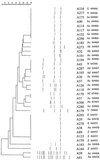Comparison of variable number tandem repeat and IS6110-restriction fragment length polymorphism analyses for discrimination of high- and low-copy-number IS6110 Mycobacterium tuberculosis isolates
- PMID: 11427553
- PMCID: PMC88169
- DOI: 10.1128/JCM.39.7.2453-2457.2001
Comparison of variable number tandem repeat and IS6110-restriction fragment length polymorphism analyses for discrimination of high- and low-copy-number IS6110 Mycobacterium tuberculosis isolates
Abstract
The present study was designed to evaluate the use of variable number tandem repeat (VNTR) and IS6110-restriction fragment length polymorphism (RFLP) analyses in combination as a two-step strategy for discrimination (as measured by the Hunter-Gaston Discrimination Index [HGDI]) of both high- and low-copy-number IS6110 Mycobacterium tuberculosis isolates compared to IS6110-RFLP alone with an unselected collection of isolates. Individually, IS6110-RFLP fingerprinting produced six clusters that accounted for 69% of the low-copy-number IS6110 isolates (five clusters) and 5% of the high-copy-number IS6110 isolates (one cluster). A total of 39% of all the isolates were clustered (HGDI = 0.97). VNTR analysis generated a total of 35 different VNTR allele profile sets from 93 isolates (HGDI = 0.938). Combining IS6110-RFLP analysis with VNTR analysis reduced the overall percentage of clustered isolates to 29% (HGDI = 0.988) and discriminated a further 27% of low-copy-number isolates that would have been clustered by IS6110-RFLP alone. The use of VNTR analysis as an initial typing strategy facilitates further analysis by IS6110-RFLP, and more importantly, VNTR analysis subdivides some IS6110-RFLP-defined clusters containing low- and single-copy IS6110 isolates.
Figures


References
-
- Alito A, Morcilli N, Scipioni S, Dolmann A, Romano M I, Cataldi A, van Soolingen D. The IS6110 restriction fragment length polymorphism in particular multidrug-resistant Mycobacterium tuberculosis strains may evolve too fast for reliable use in outbreak investigation. J Clin Microbiol. 1999;37:788–791. - PMC - PubMed
-
- Burman W J, Reves R R, Hawkes A P, Rietmeijer C A, Yang Z H, el Hajj H, Bates J H, Cave M D. DNA fingerprinting with two probes decreases clustering of Mycobacterium tuberculosis. Am J Respir Crit Care Med. 1997;155:1140–1146. - PubMed
-
- De Boer A S, Borgdorff M W, de Haas P E W, Nagelkerke N J D, van Embden J D A, van Soolingen D. Analysis of rate of change of IS6110 RFLP patterns of Mycobacterium tuberculosis based on serial patient isolates. J Infect Dis. 1999;180:1238–1244. - PubMed
Publication types
MeSH terms
Substances
LinkOut - more resources
Full Text Sources
Other Literature Sources

